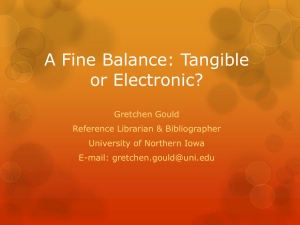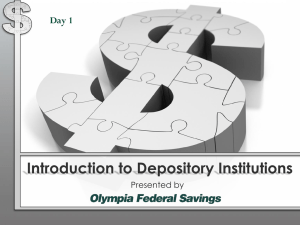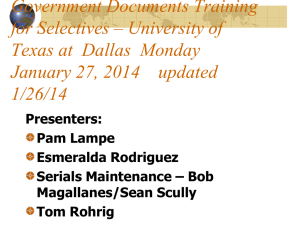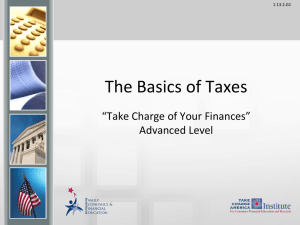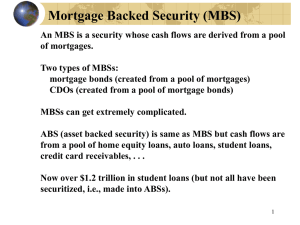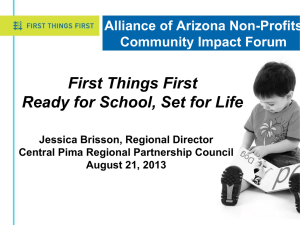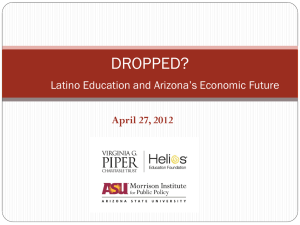Financial Institution Lecture PPT Financial Institutions 1.7.3.G1
advertisement
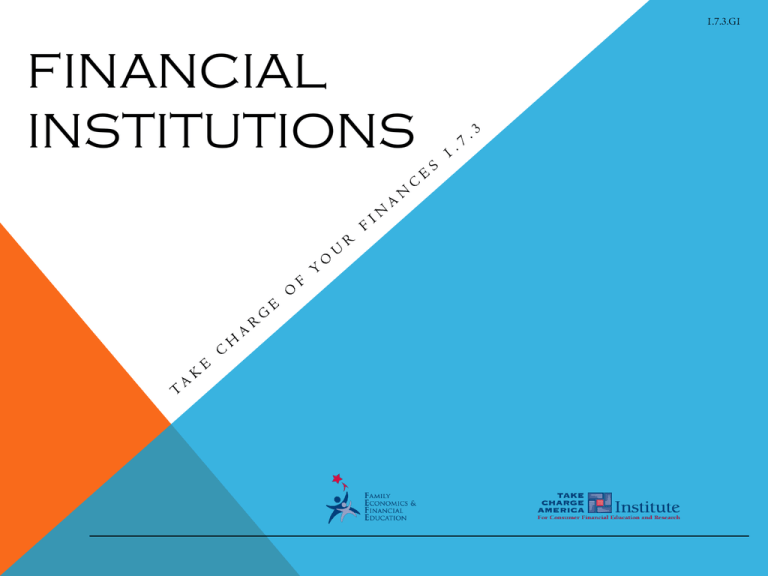
1.7.3.G1 FINANCIAL INSTITUTIONS 1.7.3.G1 FINANCIAL INSTITUTIONS Businesses which offer multiple services in banking and finance They include: Banks Savings and Loans Credit Unions They are regulated by various state and federal agencies © Family Economics & Financial Education – Revised May 2010 – Depository Institutions Unit – Depository Institutions – Slide 2 Funded by a grant from Take Charge America, Inc. to the Norton School of Family and Consumer Sciences at the University of Arizona 1.7.3.G1 FINANCIAL INSTITUTIONS Why consumers may use them: Why consumers may not use them: To have the opportunity to receive lower cost loan To receive the advantages of interest earning accounts They wish to keep their financial information private To keep money safe Fees are too high Minimum balances required are too high © Family Economics & Financial Education – Revised May 2010 – Depository Institutions Unit – Depository Institutions – Slide 3 Funded by a grant from Take Charge America, Inc. to the Norton School of Family and Consumer Sciences at the University of Arizona 1.7.3.G1 FEDERAL RESERVE BANK Services include: Collecting checks The “Fed” is part of the central banking system in the United States Distributing and receiving cash and coin Electronically transferring funds © Family Economics & Financial Education – Revised May 2010 – Depository Institutions Unit – Depository Institutions – Slide 4 Funded by a grant from Take Charge America, Inc. to the Norton School of Family and Consumer Sciences at the University of Arizona 1.7.3.G1 FEDERAL RESERVE REGIONAL LOCATIONS © Family Economics & Financial Education – Revised May 2010 – Depository Institutions Unit – Depository Institutions – Slide 5 Funded by a grant from Take Charge America, Inc. to the Norton School of Family and Consumer Sciences at the University of Arizona 1.7.3.G1 LIFE OF A DEPOSITED CHECK Step 1: A check is deposited… Step 5: The check writer’s bank deducts the amount from the account Step 4: From here it goes to the check writer’s bank Step 2: The depositor’s bank encodes, endorses, and sends the check to the reserve bank in the region or to a private clearing house Step 3: Then the check makes its way to the regional reserve bank, or the clearinghouse for the region where the check originated © Family Economics & Financial Education – Revised May 2010 – Depository Institutions Unit – Depository Institutions – Slide 6 Funded by a grant from Take Charge America, Inc. to the Norton School of Family and Consumer Sciences at the University of Arizona 1.7.3.G1 FINANCIAL INSTITUTIONS Commercial Bank Credit Union Savings and Loan Association © Family Economics & Financial Education – Revised May 2010 – Depository Institutions Unit – Depository Institutions – Slide 7 Funded by a grant from Take Charge America, Inc. to the Norton School of Family and Consumer Sciences at the University of Arizona 1.7.3.G1 COMMERCIAL BANKS Commercial Banks Usually the largest depository institutions Considered full-service depository institutions Available to a variety of consumers Examples – Wells Fargo, US Bank, Chase Bank © Family Economics & Financial Education – Revised May 2010 – Depository Institutions Unit – Depository Institutions – Slide 8 Funded by a grant from Take Charge America, Inc. to the Norton School of Family and Consumer Sciences at the University of Arizona 1.7.3.G1 CREDIT UNION Credit Unions Non-profit cooperative depository institution Owned by members who share a common bond Examples –Boeing Employee Credit Union, Verity Credit Union © Family Economics & Financial Education – Revised May 2010 – Depository Institutions Unit – Depository Institutions – Slide 9 Funded by a grant from Take Charge America, Inc. to the Norton School of Family and Consumer Sciences at the University of Arizona SAVINGS AND LOAN ASSOCIATION (S&LS) Savings and Loan Association Focus on providing loans and mortgages Customers must have a savings account with them Examples – American Federal Savings Bank, Pioneer Federal Savings & Loan. © Family Economics & Financial Education – Revised May 2010 – Depository Institutions Unit – Depository Institutions – Slide 10 Funded by a grant from Take Charge America, Inc. to the Norton School of Family and Consumer Sciences at the University of Arizona 1.7.3.G1 1.7.3.G1 TYPES OF INSURANCE Federal Deposit Insurance Corporation (FDIC) Federal government agency which protects depository institution accounts Insures commercial banks and savings and loan associations National Credit Union Administration (NCUA) Provides insurance for credit unions © Family Economics & Financial Education – Revised May 2010 – Depository Institutions Unit – Depository Institutions – Slide 11 Funded by a grant from Take Charge America, Inc. to the Norton School of Family and Consumer Sciences at the University of Arizona 1.7.3.G1 INSURANCE PROTECTION Insurance protection Each depositor is insured up to $250,000 for money deposited in a regular account and $250,000 for retirement deposits Available from both FDIC and NCUA Insurance is important because of the risk of loss Risk of Loss is used to determine which party should be responsible for damage or loss of products after a service transaction has been completed but prior to delivery © Family Economics & Financial Education – Revised May 2010 – Depository Institutions Unit – Depository Institutions – Slide 12 Funded by a grant from Take Charge America, Inc. to the Norton School of Family and Consumer Sciences at the University of Arizona 1.7.3.G1 INTEREST Interest - the amount of money that is either gained or lost when accessing services offered by a depository institution Interest rate - the percentage used annually to calculate the total interest either gained or lost Type of account Interest rate Impact on the consumer Interest bearing - money earned from an investment instrument High More money earned by the consumer Low Less money earned Interest bearing - the charge for money that a consumer borrows from a depository institution High More money paid by the consumer Low Less money paid Credit unions typically offer rates which have the most positive impact on the consumer © Family Economics & Financial Education – Revised May 2010 – Depository Institutions Unit – Depository Institutions – Slide 13 Funded by a grant from Take Charge America, Inc. to the Norton School of Family and Consumer Sciences at the University of Arizona 1.7.3.G1 FINANCIAL INSTITUTION SERVICES © Family Economics & Financial Education – Revised May 2010 – Depository Institutions Unit – Depository Institutions – Slide 14 Funded by a grant from Take Charge America, Inc. to the Norton School of Family and Consumer Sciences at the University of Arizona 1.7.3.G1 COMMON SERVICES OFFERED Checking account Savings account Also known as a Share Draft Account at a credit union Also known as a Share Account at a credit union Paper checks or debit cards that are used to withdraw money An account in which money is typically deposited to earn interest May or may not be interest earning Interest earning © Family Economics & Financial Education – Revised May 2010 – Depository Institutions Unit – Depository Institutions – Slide 15 Funded by a grant from Take Charge America, Inc. to the Norton School of Family and Consumer Sciences at the University of Arizona 1.7.3.G1 INTEREST BEARING ACCOUNTS Stock • Ownership, represented by shares in a corporation Certificate of Deposit • Share certificate account at a credit union • An insured interest – earning savings instrument with restricted access to the funds Money Market Account • An account which offers higher interest rates than a savings account and may offer limited check writing privileges Bond • A debt instrument issued by an organization such as a business or the government • Designed as an investment for the purchasers to earn interest © Family Economics & Financial Education – Revised May 2010 – Depository Institutions Unit – Depository Institutions – Slide 16 Funded by a grant from Take Charge America, Inc. to the Norton School of Family and Consumer Sciences at the University of Arizona 1.7.3.G1 INTEREST BEARING ACCOUNTS Credit Card A card used to make a purchase now and repay later If the balance is paid before the grace period ends, interest is not added If the balance is paid after the grace period, the payment of interest is required Loan Money borrowed and paid back with interest Mortgage – loan for a home Personal – interest rates vary depending upon type of loan Loan types can include vehicle, school, etc. © Family Economics & Financial Education – Revised May 2010 – Depository Institutions Unit – Depository Institutions – Slide 17 Funded by a grant from Take Charge America, Inc. to the Norton School of Family and Consumer Sciences at the University of Arizona ADDITIONAL SERVICES WHICH MAY BE OFFERED Safe-Deposit Box A secured box in a bank to be used for valuable and important personal items. Financial Counseling Information and advice is given to customers to help make financial decisions. © Family Economics & Financial Education – Revised May 2010 – Depository Institutions Unit – Depository Institutions – Slide 18 Funded by a grant from Take Charge America, Inc. to the Norton School of Family and Consumer Sciences at the University of Arizona 1.7.3.G1 1.7.3.G1 REVIEW Money management is part of everyday life! Depository institutions offer multiple services – shop around for the one which best fits your needs! Ensure the depository institution is insured by the FDIC or NCUA Comparison shop the financial services and interest rates offered before choosing © Family Economics & Financial Education – Revised May 2010 – Depository Institutions Unit – Depository Institutions – Slide 19 Funded by a grant from Take Charge America, Inc. to the Norton School of Family and Consumer Sciences at the University of Arizona
